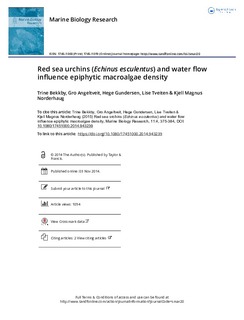| dc.contributor.author | Bekkby, Trine | |
| dc.contributor.author | Angeltveit, Gro | |
| dc.contributor.author | Gundersen, Hege | |
| dc.contributor.author | Tveiten, Lise Ann | |
| dc.contributor.author | Norderhaug, Kjell Magnus | |
| dc.date.accessioned | 2018-08-08T13:15:00Z | |
| dc.date.available | 2018-08-08T13:15:00Z | |
| dc.date.created | 2014-07-27T19:50:15Z | |
| dc.date.issued | 2015 | |
| dc.identifier.citation | Marine Biology Research. 2015, 11 (4), 375-384. | nb_NO |
| dc.identifier.issn | 1745-1000 | |
| dc.identifier.uri | http://hdl.handle.net/11250/2508076 | |
| dc.description.abstract | The importance of forests of the kelp Laminaria hyperborea along the Norwegian coast is related to the three dimensional structure that they create together with the associated macroalgae. Today, kelp forests have recovered in several areas after an extensive overgrazing by green sea urchins (Strongylocentrotus droebachiensis). However, red sea urchins (Echinus esculentus) have been observed grazing on kelp and algae in recently recovered kelp forests. Apart from grazing pressure, the abundance of algae depends on environmental conditions, such as light and water flow. The main aim of this study was to analyse how densities of red sea urchins, wave exposure and current speed influence densities of epiphytic macroalgae associated with kelp stipes. Our results show that the density of red sea urchins had a negative effect on macroalgal densities. In the welldeveloped kelp forest (i.e. in a late successional stage found in the southern region), macroalgal density decreased with depth and increased with water flow, both in terms of waves and currents. Wave forces had a higher effect than tidal-driven currents. In the recently recovered kelp forests (in the northern region), we found lower densities of epiphytic macroalgae in shallow compared to deep waters, most likely caused by red sea urchin grazing. Our study concludes that water flow is important for the ecological function of the kelp forest through the influence on habitat-forming epiphytic macroalgae, and that grazing by red sea urchins might severely affect kelp forest resilience in recently recovered areas. | nb_NO |
| dc.language.iso | eng | nb_NO |
| dc.publisher | Taylor & Francis | nb_NO |
| dc.relation.uri | http://www.tandfonline.com/doi/pdf/10.1080/17451000.2014.943239 | |
| dc.rights | Attribution-NonCommercial-NoDerivatives 4.0 Internasjonal | * |
| dc.rights.uri | http://creativecommons.org/licenses/by-nc-nd/4.0/deed.no | * |
| dc.title | Red sea urchins (Echinus esculentus) and water flow influence epiphytic macroalgae density | nb_NO |
| dc.title.alternative | Red sea urchins (Echinus esculentus) and water flow influence epiphytic macroalgae density | nb_NO |
| dc.type | Journal article | nb_NO |
| dc.type | Peer reviewed | nb_NO |
| dc.description.version | publishedVersion | nb_NO |
| dc.rights.holder | © 2014 The Author(s). | nb_NO |
| dc.source.pagenumber | 375-384 | nb_NO |
| dc.source.volume | 11 | nb_NO |
| dc.source.journal | Marine Biology Research | nb_NO |
| dc.source.issue | 4 | nb_NO |
| dc.identifier.doi | 10.1080/17451000.2014.943239 | |
| dc.identifier.cristin | 1144414 | |
| dc.relation.project | Nærings- og fiskeridepartementet: National program for mapping biodiversity - Coast | nb_NO |
| dc.relation.project | Klima- og miljødepartementet: National program for mapping biodiversity - Coast | nb_NO |
| cristin.unitcode | 7464,20,11,0 | |
| cristin.unitname | Marin biologi | |
| cristin.ispublished | true | |
| cristin.fulltext | original | |
| cristin.qualitycode | 1 | |

